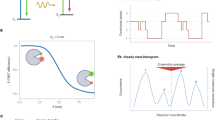Abstract
Recent developments in cell biology and microscopy techniques enable us to observe macromolecular assemblies in their natural setting: the living cell. These emerging technologies have revealed novel concepts in nuclear cell biology. In order to further elucidate the biochemistry of gene expression, replication, and genome maintenance, the major challenge is now to precisely determine the dynamics of nuclear proteins in the context of the structural organization of the nucleus. Fluorescence correlation spectroscopy (FCS) is an attractive alternative to photobleaching and photoactivation techniques for the analysis of protein dynamics at single-molecule resolution. Here we describe how FCS can be applied to retrieve biophysical parameters of nuclear proteins in living cells.
Access this chapter
Tax calculation will be finalised at checkout
Purchases are for personal use only
Similar content being viewed by others
References
Hemmerich, P. and Diekmann S. (eds.) (2005) Visions of the cell nucleus. American Scientific Publishers, CA, USA
Misteli, T. (2001) Protein dynamics: implications for nuclear architecture and gene expression. Science. 291, 843-847
von Mikecz, A. and Hemmerich, P. (2005) Subnuclear pathology. In: Visions of the cell nucleus (Diekamnn, S. and Hemmerich, P. eds.), American Scientific Publishers, CA, USA, pp. 184-203
Magde, D. Elson, E. and Webb, W.W. (1972) Thermodynamic fluctuations in a reacting system—measurement by fluorescence correlation spectroscopy. Phys. Rev. Lett. 29, 705-708
Widengren, J. and Mets, Ü. (2002) Conceptual basis of fluorescence correlation spectroscopy and related techniques as tools in bioscience. In: Single-molecule detection in solution—methods and applications (Zander, C., Enderlein, J., and Keller, R. A., eds.) Wiley-VCH, Berlin
Rigler, R. and Widengren, J. (1990) Ultrasensitive detection of single molecules by fluorescence correlation spectroscopy. Biosciences. 3, 180-183
Enderlein, J., Gregor, I., Patra, D., and Fitter, J. (2004) Art and artefacts of fluorescence correlation spectroscopy. Curr. Pharm. Biotechnol. 2, 155-161
Bacia, K. and Schwille, P. (2003) A dynamic view of cellular processes by in vivo fluorescence auto- and cross correlation spectroscopy. Methods. 29, 74-85
Schmiedeberg, L., Weisshart, K., Diekmann, S., Meyer Zu Hoerste, G., and Hemmerich, P. (2004) High and low mobility populations of HP1 in heterochromatin of mammalian cells. Mol. Biol. Cell. 15, 2819-2833
Schwille, P., Meyer-Almes, F.-R., and Rigler, R. (1997) Dual-color fluorescence cross-correlation spectroscopy for multicomponent diffusional behaviour in solution. Biophys. J. 72, 1878-1886
Wachsmuth, M., Weidemann, T., Muller, G., Hoffmann-Rohrer, U.W., Knoch, T.A., Waldeck, W., and Langowski, J. (2003) Analyzing intracellular binding and diffusion with continuous fluorescence photobleaching. Biophys. J. 84, 3353-3363
Chen, Y., Müller, J.D., Ruan, Q., and Gratton, E. (2002) Molecular brightness characterization of EGFP in vivo by fluorescence fluctuation spectroscopy. Biophys. J. 82, 133-144
Jankowski, T. and Janka, R. (2001) in Fluorescence correlation spectroscopy: theory and applications (Rigler, R., and Elson, E. L., Eds.), Vol. 65, Springer, Berlin Heidelberg. pp. 331-345
Weisshart, K., Jungel, V., and Briddon, S.J. (2004) The LSM 510 META - ConfoCor 2 system: an integrated imaging and spectroscopic platform for single-molecule detection. Curr. Pharm. Biotechnol. 2, 135-154
Magde, D., Elson, E.L., and Webb, W.W. (1974) Fluorescence correlation spectroscopy. II. An experimental realization. Biopolymers. 1, 29-61
Meseth, U., Wohland, T., Rigler, R., and Vogel, H. (1999) Resolution of fluorescence correlation measurements. Biophys. J. 3, 1619-1631
Haustein, E. and Schwille, P. (2003) Ultrasensitive investigations of biological systems by fluorescence correlation spectroscopy. Methods. 2, 153-156
Muller, J.D., Chen, Y., and Gratton, E. (2003) Fluorescence correlation spectroscopy. Methods Enzymol. 361, 69-92
Hink, M.A., Borst, J.W., and Visser, A.J. (2003) Fluorescence correlation spectroscopy of GFP fusion proteins in living plant cells. Methods Enzymol. 361, 93-112
Skakun, V.V., Hink, M.A., Digris, A.V., Engel, R., Novikov, E.G., Apanasovich, V.V., and Visser, A. J. (2005) Global analysis of fluorescence fluctuation data. Eur. Biophys J. 4, 323334. (Erratum in Eur. Biophys. J. (2005) 7, 972)
Author information
Authors and Affiliations
Editor information
Editors and Affiliations
Rights and permissions
Copyright information
© 2008 Humana Press, a part of Springer Science + Business Media, LLC
About this protocol
Cite this protocol
Weidtkamp-Peters, S., Weisshart, K., Schmiedeberg, L., Hemmerich, P. (2008). Fluorescence Correlation Spectroscopy to Assess the Mobility of Nuclear Proteins. In: Hancock, R. (eds) The Nucleus. Methods in Molecular Biology, vol 464. Humana Press, Totowa, NJ. https://doi.org/10.1007/978-1-60327-461-6_18
Download citation
DOI: https://doi.org/10.1007/978-1-60327-461-6_18
Publisher Name: Humana Press, Totowa, NJ
Print ISBN: 978-1-60327-460-9
Online ISBN: 978-1-60327-461-6
eBook Packages: Springer Protocols




